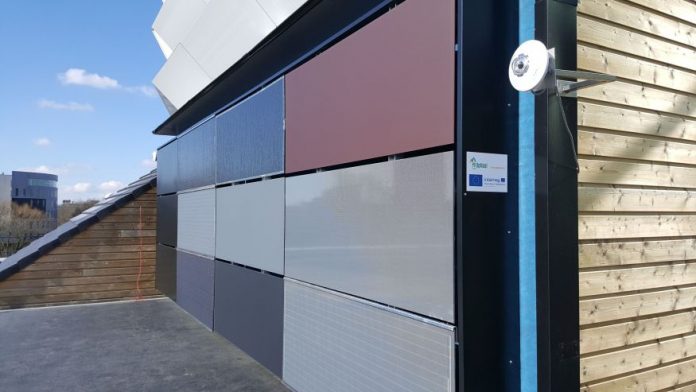Since 2014, the Netherlands Organisation for Applied Scientific Research (TNO) has been testing different kinds of innovative solar panels, including BIPV modules with different colors, at its SolarBEAT testing facility at Eindhoven University of Technology.
According to Roland Valckenborg, the manager of the project, colored modules are still more expensive than traditional PV modules, but consumer interest is increasing. “People want to have a choice between different models, just as with cars,” he told pv magazine.
Performance parameters
Valckenborg said the performance of colored BIPV modules has been underestimated. “It was such a pleasant surprise to find out in our research that the textured modules have no performance loss when compared to a normal reference module,” he claimed. “So the small losses due to the extra layer of textured glass are offset by the gain of capturing a bit more yield during low angles of incidence.”
When the first tests started in 2017, it was still believed that colored panels would reduce yield by 40% to 50%. “We demonstrated in 2018 that it is just 11% for grey modules,” Valckenborg stated.
The results have been confirmed by research institutes such as the University of Applied Sciences and Arts of Southern Switzerland (SUPSI).
Light reflection
When asked how much color affects light reflection, Valckenborg said a minimal reduction must be taken into account. “When we want a colored PV panel, we have to accept that not all the visible solar spectrum will be transmitted to the cell, but part of it will be reflected or absorbed,” he stated. In conventional, uncolored PV panels, all layers on top of the solar cells – the front glass and the encapsulant – must be optimized to be as transparent as possible, in order to allow light to be transmitted and reach the solar cells.

There are currently two main approaches to coloring PV panels: a technique consisting of pigment-based coloration, and a structural coloration method. The first technique refers to the application of dyes and pigments that mainly absorb and partially reflect specific parts of the spectrum. This is the case, for instance, with colored dots printed on the front PV glass or on colored encapsulant.
Structural coloration is obtained through the interaction of the light itself with nano-structured surfaces or multi-layer thin-film coatings. Interference filters deposited on glass exploit the interference effect to selectively reflect only a narrow portion of the visible spectrum.
The way a color is obtained, and how it affects the performance of a PV panel, therefore strongly depends on the specific technology used and the optical phenomena taking place.
“Ideally, a colored PV panel should be able to reflect only a narrow band of the visible spectrum and transmit all the rest,” Valckenborg explained. “In this way we will perceive the module with the color corresponding to that specific reflected wavelength, while the rest of the sunlight spectrum can be effectively used for power generation”
In order to avoid additional losses, the colored layer (glass or encapsulant or extra layer) should be non-absorptive, he noted.
Performance losses
The performance losses of colored PV are mainly due to the lower amount of photons that are transmitted to the solar cells, which in turn leads to lower current and reduced power production. Power losses for colored PV products now available on the market range from approximately 10% to 40%. Losses also strongly depend on the specific color, because each color is characterized by a specific reflection spectrum, according to Valckenborg.
“Pigment-based colors always absorb part of the spectrum. In this respect, paintings which can be considered better than others are those characterized by low absorption,” he claimed.

In terms of higher performance, interference coating is currently the best option. Filters can be made with completely non-absorptive materials, and their reflection peak can be tuned to be as narrow as possible.
“Drawbacks of this technology are more related to price and other aspects, such as the angular dependency of the color,” Valckenborg explained. “In general, a compromise must always be found between electrical performance, cost and aesthetic quality.”
Vertical PV
One reason colored modules are still significantly more expensive than conventional panels is because the building industry is actually quite conservative, and for good reason, according to Valckenborg. As a facade element, BIPV colored modules must comply with strict safety requirements and be strong enough to avoid failures of any kind. “Because if something fails then the costs of repair can be huge,” he explained.
Colored modules are considered ideal for facade applications. “First, because facades are much more visible than roofs,” Valckenborg said. “Secondly, because the euro/m2 for a facade is already significantly higher than for a pitched roof. So the relative added cost of color is much lower for the facade application.”
Valckenborg noted that BIPV panels on pitched roofs are still a niche market.
“In the Netherlands we start to see more infrastructure integrated PV (IIPV), which includes all applications into noise barriers, dikes, and roads. Because these applications are visible, they might become colored one day,” he concluded.






